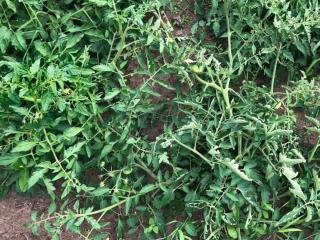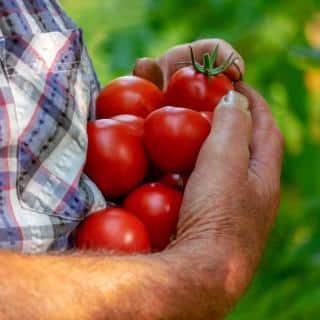

Growing tomatoes without stakes or cages allows for an abundant harvest: one plant will produce as much as three staked tomatoes.
Without any of the hassle, too!
Read also:
The first requirement to succeed in growing no-stake tomatoes is space: in the garden, a single tomato plant will cover more than a square yard (meter). Varieties that have limited growth – ‘Felicia’, ‘Ferline’, cherry tomato, plum tomato – are perfect for this technique.
After planting, your tomato plants will feel right at home and spread around. The main stem will wind all over the place, and the plant will grow many leaves: two sure signs that fruit-bearing will be abundant.
Plant your tomato plants in mid-May, early enough for an end-of-summer harvest lasting even until the first frost spells. Add a handful of crushed nettles in each planting hole, and water once or twice to ensure settling in.

The goal is to keep fruits from touching the soil directly.
This planting technique is also appropriate for use in a greenhouse. Inside, since soil stays dry, tomatoes will form well even if they rest upon it.
→ Note: in this case (greenhouse), it helps to set up an irrigation system because trudging through your ‘maters at knee-height isn’t something you want to do every day.
Once your plants have settled in, prune the two topmost leaf crowns and only keep the lower ones. After that, just let the stems run around. Water reasonably, once a fortnight with drip irrigation if the weather is dry.

Minimal care for maximum harvest!
→ Read about the opposite: how to stake tomato
M.-C. H.
This system actually reproduces how tomatoes naturally grow in the wild. They would either climb up over shrubs and bushes, or crawl along the ground to spread.
My veg patch is in a publicly viewable area of my yard, and I have always disliked how the plants look caged/trellis- and they look even worse when I don’t have time to tend to them! I thought I was done with them because of the intensive time Required, but this article has encouraged me to try this method this year, thank you!
How do I get mulch under my tomato plants without harming them? They are already out of control.
I have several stems that have spouted roots and well rooted into the soil.
Rooting stems are one of the strengths of no-stake growing: it helps plants find nutrients in new places, and the distance to fruiting branches is shorter, too. So in itself, the rooting is a good thing.
You’re right that adding mulch is more difficult. Here are a few things I can suggest to make this easier:
First, make yourself a few stepping stones. Or slabs of wood. You can try out hollow or cinder blocks, too, if that’s what’s available. The goal is to create a path that can bring you to every part of the patch. Make them around 6 inches tall, and wide enough for you to turn around with both feet comfortably, or even kneel or squat on them. Also, make sure they’re stable. Test the spacing between tiles by still carrying one or two as you go, it’s better to make them closer together than further apart. That way, you limit the space you need to clear to just being able to cross around safely.
Second, regarding mulch: In such a patch, mulch is far less necessary, since the vines are providing their own soil cover. Mulch is especially useful on bare soil, but in this case the tomato vine itself is the “cover plant”! So don’t fret that you absolutely need to get it done or everything will die, this isn’t the case. Of course, mulch always helps, so let’s look into how to spread it. Depending on the size of the mulch, you’d go about it differently.
– If it’s a long, strand-filled mulch like hay or brf, I find it easier to handle this way: grasp two fistfuls and twist them into a bundle. Then, slide the bundle with one hand under the leaves, holding branches and foliage up with the other hand. Repeat to cover the area. This helps keep rooted portions in place.
– If it’s piecemeal mulch, like wood clippings, grass trimmings or cocoa hulls, the hard way is to pour it first in a wide tub or basin, and then scoop it up with a cut-up milk jug (those with handles you can cut into). Then hold foliage up with one hand and spread it out from your makeshift trowel with the other. The easiest way is to get some in a pail, and make it rain down on the plants, somewhat delicately so as to not hurt them. Then, give the plants a shake to make the mulch fall down from the leaves. Real rain will take care of any smaller bits that get stuck here and there, don’t worry about them.
Hi,
Four of my determinate tomatoes were caged when small and I was able to trim sun leaves and give it more ventilation. They seem to be doing very well.
The other 10 are crawling and re rooting themselves and some of the tomatoes are getting close to the ground. My husband is wanting to put sections of landscape material under them as he doesn’t want to mess with mulch. Will this work?
As for my romas, they stayed quite compact and are not crawling. Should I trim the sun leaves, that are touching the ground, on the romas?
We’ve had blight in our garden years ago and we are a bit worried these will get it too.
We have a total of 66 tomato plants, most of which I’ll can and the others will be handed off to friends and family. Thank you for your time.
Hello, Tina. Yes, the landscaping material would work very well instead of mulch. Remember to pick the pieces up after the season is over, you wouldn’t want any plastic sheeting left over (unless its a harmless biodegradable material).
It’s normal that leaves touch the ground in this system, and you can reduce soil contact by cutting them off just as you suggest. It would help prevent blight, but I find it really impractical on a day-to-day basis, since vines are always growing and falling over. I’d go with either the landscaping fabric, or mulch: both will keep a distance to the soil and leaves that fall over won’t be as vulnerable.
Excellent growing !
I used this method to put Isis Candy tomatoes into a hugelkultur bed without sides so the plants can start on a hill and sprawl down. I love this advice you provide because really it is sometimes too difficult to provide trellising or other support to a large # of plants. I grew quite a few indeterminate tomatoes with support but now I wanted to start another set since I live in an area of the US with a long growing season. This way, I can keep my earlier plants that are still producing while adding some more.
That’s true! Since this technique requires far less work, it’s a great way to maximize space use.
I plan on trying this this year. Keeping 18 plants upright really take a lot of time. I plan on slipping squares of cardboard under clusters of tomato’s and trying to water predominantly at the stem.
Hi Clint! That’s great to hear. It’s sure to work fine, especially if you’re careful to water at the stem. Instead of cardboard, I’d suggest a slab of wood or a split log: it won’t get mushy if it rains.
I have a small farm in Andalucia. Locally it is quite common for tomatoes to be grown on the ground, particularly the large beef varieties. There is of course little issue with contact with soil because the earth is so dry throughout the growing season, Flood watering is general used with water soon draining into the soil and allowing the surface to dry out quickly.
That’s a very interesting comment, thanks a lot for the input. Flood watering for tomatoes is a first for me, I’ve never seen it in action. Must look nice to have a swamped patty with tomatoes sticking out of it! Isn’t it difficult to manage irrigation to get enough water for the flooding?
My family accidentally grew tomato plants in their patio and we haven’t seen anything like it sprawled across the floor it thrives with little to no care and the patch it’s in is what an inch thick so even minimal growing conditions! I have harvested so many tomatoes so far and there are still loads left to go. This is definitely our new way of growing tomatoes. Definitely do recommend!
That’s a great story! It’s clearly a good thing, letting the vine grow wild does wonders for productivity! It also perhaps helped that it had a nice, clean surface to crawl along; in my experience it’s important to have either a clean surface or a lot of clean mulch, like hay or straw. If there’s too much direct contact with dirt and soil, sometimes disease appears and spreads through.
THIS IS THE WORST TOMATO GROWING ADVICE IVE EVER READ. I PLANT MY TOMATOES 12 INCHES APART, SINGLE STEM, UP A ROPE OR STAKE.NOT ONLY DOES THIS WASTE GARDEN SPACE, BUT YOUR METHOD ALSO CREATES DISEASE AND SLUG/PEST PRESSURE.
Well, thank you for contributing! It’s an article that describes that it is in fact possible to plant tomatoes without using stakes. Some gardeners like the idea, and this advice helps guide them specifically to reduce diseases and pest pressure in this case. Others might say that this technique, though it does need more space, will save time, so it’s a trade-off that’s worth it. As some would put it, better a few tomatoes in a garden with no need to maintain, than zero tomatoes just because “you have to do it the right way”!
In short, it’s nice to have your contribution, since it illustrates how important it is to give gardeners options, not close doors.
I recently had a young plant fall. I was worried the stem snapped, but then I realized it was intact and resembled a squash vine/stem which brought me here. Now I know I’m not crazy, and realizing that’s what did/do plants in the wild do!
Next year will be different for sure. Thanks for taking the time to write this up.
We planted 2 juliet, 2 Roma, 2 various cherrie, 1 big boy, 2 midnight snackers and 1 other slicing variety. Started trying to stake and tie, etc. Got tired of being slaves to the tomatoes plants and constantly having to add stakes and support. Abandoned all stakes and ties, put a good layer of wood chips under them, and just let em grow wild like God intended! Those sonofaguns started spreading and rooting all over! Some of the vines are as thick as my thumb and we have 3 times as many tomatoes per plant than we ever had before and with absolutely minimum effort!!
Tomato stems are indeed prone to breaking when grown tall, whereas if left to crawl around they stay much more flexible. At times, where the stem touches the ground, it’ll even sprout roots and grow even more vigorously!